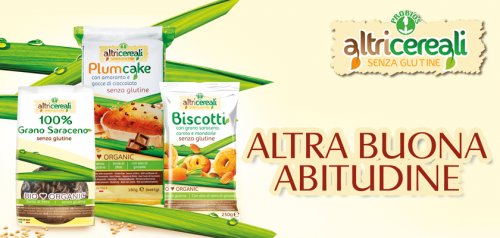
Considerating that the term "corn" is neither scientific nor botanist but commodity- related and literary, let us get to know those who are defined as "pseudo cereal" ie those edible beans that despite not belonging to the grass family, still used in a very similar way as traditional cereals. The three plants we meet produce beans that we will discover valuable from a nutritional point of view, naturally gluten-free, that's why they are rediscovered with pleasure even in the recipes of those who follow a diet where gluten should be excluded.
The amaranth is a plant native to Central America, there are about sixty species but the following three of them are edible: Amaranthus caudatus, Amaranthus cruentus and Amaranthus hypochondriacus. It is assumed that there was a variety already known to the Greeks, so that in the mythological tales, it is said that the Greek goddesses used them as ornamental wreaths. Aesop dedicated one of his fables with moral background to them, "The Rose and the Amaranth”.
The ancient native peoples of the countries that today correspond to Mexico, even before the Mayas and Aztecs, in addition to traditional crops of beans, peppers, chilies, chia seeds, and the world famous corn, cultivated and consumed abundantly also the amaranth plant, as confirmed by recent archaeological studies. They used the leaves, similar to spinach, but mainly beans. The Aztecs called it "the grain of the Gods" for the use that they made during religious rites: the kneaded it together with corn flour and then they made the celebratory figures before eating after the rite. With amaranth they prepared a very nutritious drink sweetened with honey, Atole amaranth.
Its use was superimposed and complementary to corn. It was essential in the diet of poor people who often lived in the mountainous and arid areas. If we think in terms of value in vegetable protein, fiber and minerals we understand the importance that had this plant in the daily diet of these populations. But with the arrival of the conquistadors in the early sixteenth century, its cultivation stopped suddenly for the forced introduction of European cereals.
Its spread in Europe took place as an ornamental plant for its flowers of a beautiful bright red; in Africa from 800 it was cultivated as a vegetable and in Asia as corn, but never it achieved the importance that it had in the countries of origin. The rediscovery of the seed took place in the mid-seventies, and currently is grown and marketed in Mexico, South America, United States, China, Poland and Austria. Among its nutritional feature also the easy digestion is appreciated. It is cooked in water in the ratio 1: 2.5 in 30/40 minutes and it can be used for the preparation of croquettes, little timbales, skipped with vegetables.
The QUINOA (Chenopodium quinoa Willd.) Is an annual herbaceous plant, with round seeds, similar to the mile, from which you can get grinding flour. It is distinguished from other cereals for the high protein content and because of this it constitutes the food "cornerstone" of the diet of the Andean people. Is cultivated for 5000 years in altitudes of even 4000 meters. The Incas worshiped it as a sacred plant calling it "mother of all seeds". At the time of the Spanish conquest as happened on amaranth, the conflict with the Catholic culture discouraged the cultivation and arrested the use; only later, when quinoa was obviously the best adaptation for the Andean environment against the grain, its cultivation restarted.
One of the factors that prevents the cultivation in areas like Europe are the climatic conditions: the extreme heat and high humidity do not allow this plant to grow and develop. Bolivia, Ecuador and Peru are currently the largest exporters. 2013 has been dedicated by the FAO as the Year of Quinoa own to support the dissemination of this ancient and important plant outside South America, to be able to exploit the features and make it the food of tomorrow. The Organization of the United Nations Food and Agriculture is promoting the cultivation in developing countries recognizing it as a valuable contribution in the fight against world hunger. Quinoa contains all 9 essential amino acids, in addition to a right amount of carbohydrates and proteins, these last ones in greater quantities than in cereals such as wheat, millet and rice.
Its use in the kitchen is very versatile, but needs to be rinsed before use for the removal of a group are substances called "saponins," that would otherwise give a bitter taste. Quinoa can be cooked and seasoned to taste, it is used for many salted recipes and for the preparation of biscuits and sweet creams.
The BUCKWHEAT (Buckwheat) is a species of herbaceous flowering plant, also called "black grain". It has very ancient origins, its cultivation began in Siberia in the area of Manchuria and China then continuing in Japan, India and Turkey; thanks to trade through the Black Sea it arrives in Italy in the fifteenth century.
Buckwheat is a definitely underestimated food that is mainly used in some northern European countries. In Italy it is still widely used in traditional cuisine: it is effectively in many recipes of the mountains as the "polenta taragna", the "pizzoccheri Valtellina" and "sciatt", typical Valtellina desserts. It is commonly associated with cereals but its very particular characteristics approach it even to legumes: in fact as well as it consists of carbohydrates, it has an interesting protein content and is a valuable source of fiber that reaches up to 10%. Remarkable its content of minerals such as calcium, phosphorus, potassium, magnesium, and iron and the intake of some B vitamins as well as vitamin E.Gli essential amino acids that constitute its proteins are numerous: arginine, cystine, glycine, isoleucine, lysine, methionine, to name a few.
Buckwheat as other cereals can be cooked in water and seasoned "type risotto", but it is with the flour that you can give free rein to the imagination: crepes and pastries, bread and bread sticks, until you get to pasta and polenta.





